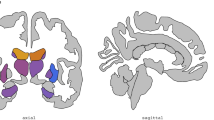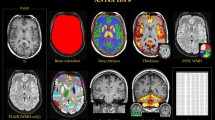Abstract
Girls and women with Turner syndrome (TS) have a completely or partially missing X chromosome. Extensive studies on the impact of TS on neuroanatomy and cognition have been conducted. The integration of neuroanatomical and cognitive information into one consistent analysis through multi-table methods is difficult and most standard tests are underpowered. We propose a new two-sample testing procedure that compares associations between two tables in two groups. The procedure combines multi-table methods with permutation tests. In particular, we construct cluster size test statistics that incorporate spatial dependencies. We apply our new procedure to a newly collected dataset comprising of structural brain scans and cognitive test scores from girls with TS and healthy control participants (age and sex matched). We measure neuroanatomy with Tensor-Based Morphometry (TBM) and cognitive function with Wechsler IQ and NEuroPSYchological tests (NEPSY-II). We compare our multi-table testing procedure to a single-table analysis. Our new procedure reports differential correlations between two voxel clusters and a wide range of cognitive tests whereas the single-table analysis reports no differences. Our findings are consistent with the hypothesis that girls with TS have a different brain-cognition association structure than healthy controls.







Similar content being viewed by others
References
Avants, B.B., Cook, P.A., Ungar, L., Gee, J.C., & Grossman, M. (2010). Dementia induces correlated reductions in white matter integrity and cortical thickness: A multivariate neuroimaging study with sparse canonical correlation analysis. NeuroImage, 50(3), 1004–1016.
Avants, B.B., Tustison, N.J., Song, G., Cook, P.A., Klein, A., & Gee, J.C. (2011). A reproducible evaluation of ANTs similarity metric performance in brain image registration. NeuroImage, 54(3), 2033–2044.
Avants, B.B., Libon, D.J., Rascovsky, K., Boller, A., McMillan, C.T., Massimo, L., Coslett, H.B., Chatterjee, A., Gross, R.G., & Grossman, M. (2014). Sparse canonical correlation analysis relates network-level atrophy to multivariate cognitive measures in a neurodegenerative population. NeuroImage, 84, 698–711.
Benjamini, Y., & Hochberg, Y. (1995). Controlling the false discovery rate: a practical and powerful approach to multiple testing. Journal of the Royal Statistical Society, Series B, 57(1), 289–300.
Bookstein, F.L. (1994). Partial least squares: a dose–response model for measurement in the behavioral and brain sciences. Psycoloquy, 5(23), 1.
Bray, S., Dunkin, B., Hong, D.S., & Reiss, A.L. (2011). Reduced functional connectivity during working memory in Turner syndrome. Cerebral Cortex, 21(11), 2471–2481.
Brooks, B.L., Sherman, E.M., & Strauss, E. (2009). NEPSY-II: a developmental neuropsychological assessment, 2nd Edn. Child Neuropsychology, 16(1), 80–101.
Brown, W.E., Kesler, S.R., Eliez, S., Warsofsky, I.S., Haberecht, M., & Reiss, A.L. (2004). A volumetric study of parietal lobe subregions in Turner syndrome. Developmental Medicine & Child Neurology, 46(9), 607–609.
Chi, E., Allen, G., Zhou, H., Kohannim, O., Lange, K., & Thompson, P. (2013). Imaging genetics via sparse canonical correlation analysis. In International symposium on biomedical imaging – ISBI (pp. 740–743).
Chung, M., Worsley, K., Paus, T., Cherif, C., Collins, D., Giedd, J., Rapoport, J., & Evans, A. (2001). A unified statistical approach to deformation-based morphometry. NeuroImage, 14(3), 595–606.
Davatzikos, C., Vaillant, M., Resnick, S.M., Prince, J.L., Letovsky, S., & Bryan, R.N. (1996). A computerized approach for morphological analysis of the corpus callosum. Journal of Computer Assisted Tomography, 20(1), 88–97.
Duda, J.T., Detre, J.A., Kim, J., Gee, J.C., & Avants, B.B. (2013). Fusing functional signals by sparse canonical correlation analysis improves network reproducibility. In Mori, K., Sakuma, I., Sato, Y., Barillot, C., & Navab, N. (Eds.) Medical image computing and computer-assisted intervention – MICCAI, vol. 8151 of lecture notes in computer science (pp. 635–642). Springer.
Fornell, C., & Bookstein, F.L. (1982). Two structural equation models: LISREL and PLS applied to consumer exit-voice theory. Journal of Marketing Research pp. 440–452.
Freeborough, P.A., & Fox, N.C. (1998). Modeling brain deformations in Alzheimer disease by fluid registration of serial 3D MR images. Journal of Computer Assisted Tomography, 22(5), 838–843.
Gee, J.C., & Bajcsy, R.K. (1998). Elastic matching: Continuum mechanical and probabilistic analysis. In Toga, A.W. (Ed.) Brain warping. Academic Press.
Gravholt, C.H. (2005). Clinical practice in Turner syndrome. Nature Reviews Endocrinology, 1(1), 41–52.
Green, T., Chromik, L.C., Mazaika, P.K., Fierro, K., Raman, M.M., Lazzeroni, L.C., Hong, D.S., & Reiss, A.L. (2014). Aberrant parietal cortex developmental trajectories in girls with Turner syndrome and related visual–spatial cognitive development: A preliminary study. American Journal of Medical Genetics Part B: Neuropsychiatric Genetics, 165(6), 531–540.
Hart, S.J., Davenport, M.L., Hooper, S.R., & Belger, A. (2006). Visuospatial executive function in Turner syndrome: functional MRI and neurocognitive findings. Brain, 129(5), 1125–1136.
Hong, D., Scaletta Kent, J., & Kesler, S. (2009). Cognitive profile of Turner syndrome. Developmental Disabilities Research Reviews, 15(4), 270–278.
Hong, D.S., Hoeft, F., Marzelli, M.J., Lepage, J.-F., Roeltgen, D., Ross, J., & Reiss, A.L. (2014). Influence of the X-chromosome on neuroanatomy: evidence from turner and Klinefelter syndromes. The Journal of Neuroscience, 34(10), 3509–3516.
Hotelling, H. (1936). Relations between two sets of variates. Biometrika, 28(3/4), 321–377.
Izenman, A.J. (1975). Reduced-rank regression for the multivariate linear model. Journal of Multivariate Analysis, 5(2), 248–264.
Kesler, S.R. (2007). Turner syndrome. Child and Adolescent Psychiatric Clinics of North America, 16(3), 709–722.
Kesler, S.R., Haberecht, M.F., Menon, V., Warsofsky, I.S., Dyer-Friedman, J., Neely, E.K., & Reiss, A.L. (2004). Functional neuroanatomy of spatial orientation processing in Turner syndrome. Cerebral Cortex, 14 (2), 174–180.
Krishnan, A., Williams, L.J., McIntosh, A.R., & Abdi H. (2011). Partial Least Squares (PLS) methods for neuroimaging: a tutorial and review. NeuroImage, 56(2), 455–475.
Lê Cao, K.-A., Martin, P.G., Robert-Granié, C., & Besse, P. (2009). Sparse canonical methods for biological data integration: application to a cross-platform study. BMC Bioinformatics, 10(1), 34.
Leow, A., Yanovsky, I., Chiang, M.-C., Lee, A., Klunder, A., Lu, A., Becker, J., Davis, S., Toga, A., & Thompson, P. (2007). Statistical properties of Jacobian maps and the realization of unbiased large-deformation nonlinear image registration. IEEE Transactions on Medical Imaging, 26(6), 822–832.
Lorenzi, M., Gutman, B., Hibar, D.P., Altmann, A., Jahanshad, N., Thompson, P.M., & Ourselin, S. (2016a). Partial least squares modelling for imaging-genetics in Alzheimer’s disease: Plausibility and generalization. In 13th International symposium on biomedical imaging (ISBI), IEEE (pp. 838–841).
Lorenzi, M., Simpson, I.J., Mendelson, A.F., Vos, S.B., Cardoso, M.J., Modat, M., Schott, J.M., & Ourselin, S. (2016b). Multimodal image analysis in Alzheimer’s disease via statistical modelling of non-local intensity correlations. Scientific Reports, 6, 22161.
Marshall, W.A., & Tanner, J.M. (1969). Variations in pattern of pubertal changes in girls. Archives of Disease in Childhood, 44(235), 291.
Mazzocco, M.M. (1998). A process approach to describing mathematics difficulties in girls with Turner syndrome. Pediatrics, 102(Supplement 3), 492–496.
McIntosh, A.R., & Lobaugh, N.J. (2004). Partial least squares analysis of neuroimaging data: applications and advances. NeuroImage, 23, S250–S263.
McIntosh, A., Bookstein, F., Haxby, J.V., & Grady, C. (1996). Spatial pattern analysis of functional brain images using partial least squares. Neuroimage, 3(3), 143–157.
Molko, N., Cachia, A., Rivière, D., Mangin, J.-F., Bruandet, M., Le Bihan, D., Cohen, L., & Dehaene, S. (2003). Functional and structural alterations of the intraparietal sulcus in a developmental dyscalculia of genetic origin. Neuron, 40(4), 847–858.
Nichols, T.E., & Holmes, A.P. (2002). Nonparametric permutation tests for functional neuroimaging: a primer with examples. Human Brain Mapping, 15(1), 1–25.
Parkhomenko, E., Tritchler, D., & Beyene, J. (2007). Genome-wide sparse canonical correlation of gene expression with genotypes. In BMC proceedings (Vol. 1, p. S119).
Parkhomenko, E., Tritchler, D., & Beyene, J. (2009). Sparse canonical correlation analysis with application to genomic data integration. Statistical Applications in Genetics and Molecular Biology, 8(1), 1–34.
Poline, J.-B., & Mazoyer, B.M. (1993). Analysis of individual positron emission tomography activation maps by detection of high signal-to-noise-ratio pixel clusters. Journal of Cerebral Blood Flow & Metabolism, 13(3), 425–437.
Roland, P., Levin, B., Kawashima, R., & Åkerman, S. (1993). Three-dimensional analysis of clustered voxels in 15O-butanol brain activation images. Human Brain Mapping, 1(1), 3–19.
Rovet, J.F. (1993). The psychoeducational characteristics of children with Turner syndrome. Journal of Learning Disabilities, 26(5), 333–341.
Smith, S.M. (2002). Fast robust automated brain extraction. Human Brain Mapping, 17(3), 143–155.
Smith, S.M., Nichols, T.E., Vidaurre, D., Winkler, A.M., Behrens, T.E., Glasser, M.F., Ugurbil, K., Barch, D.M., Van Essen, D.C., & Miller, K.L. (2015). A positive-negative mode of population covariation links brain connectivity, demographics and behavior. Nature Neuroscience, 18(11), 1565–1567.
Streissguth, A.P., Bookstein, F.L., Sampson, P.D., & Barr, H.M. (1993). The enduring effects of prenatal alcohol exposure on child development: Birth through seven years, a partial least squares solution. Ann Arbor: The University of Michigan Press.
Sybert, V.P., & McCauley, E. (2004). Turner’s syndrome. New England Journal of Medicine, 351(12), 1227–1238.
Tucker, L.R. (1958). An inter-battery method of factor analysis. Psychometrika, 23, 111–136. ISSN 0033-3123.
Tustison, N., Avants, B., Cook, P., Zheng, Y., Egan, A., Yushkevich, P., & Gee, J. (2010). N4ITK: improved N3 bias correction. IEEE Transactions on Medical Imaging, 29(6), 1310–1320.
Waaijenborg, S., Verselewel de Witt Hamer, P.C., & Zwinderman, A.H. (2008). Quantifying the association between gene expressions and DNA-markers by penalized canonical correlation analysis. Statistical Applications in Genetics and Molecular Biology 7(1).
Wechsler, D. (2002). Wechsler preschool and primary scale of intelligence (WPPSI-III), 3rd Edn. San Antonio: The Psychological Corporation.
Wechsler, D. (2003). Wechsler intelligence scale for children (WISC-IV), 4th Edn. San Antonio: The Psychological Corporation.
Witten, D.M., Tibshirani, R., & Hastie, T. (2009). A penalized matrix decomposition, with applications to sparse principal components and canonical correlation analysis. Biostatistics, 10(3), 515–534.
Wold, H. (1966). Estimation of principal components and related models by iterative least squares (pp. 391–420). New York: Academic Press.
Zhang, Y., Brady, M., & Smith, S. (2001). Segmentation of brain MR images through a hidden Markov random field model and the expectation-maximization algorithm. IEEE Transactions on Medical Imaging, 20(1), 45–57.
Acknowledgments
The Turner Syndrome Society and the Turner Syndrome Foundation made this work possible. The authors would like to sincerely thank all of the families who kindly volunteered to participate.
Christof Seiler was supported by two postdoctoral fellowships from the Swiss National Science Foundation (146281 and 158500) and a travel grant from the France-Stanford Center for Interdisciplinary Studies. Tamar Green was supported by a grant from the Gazit-Globe Post-Doctoral Fellowship Award. Allan L. Reiss is supported by grants from the NICHD (HD049653), NIMH (MH099630), and the Sharon Levine Foundation. Dr. Reiss is an unpaid medical advisor for the Turner Syndrome Society and Turner Syndrome Foundation. The funding sources mentioned above had no role in the study design; in the collection, analysis and interpretation of the data. Susan Holmes is supported by NICHD (HD049653).
We would like to thank two anonymous reviewers for their helpful input that greatly contributed to improved clarity and quality of this manuscript.
Author information
Authors and Affiliations
Corresponding author
Additional information
Christof Seiler and Tamar Green are joint first authors. Susan Holmes and Allan L. Reiss are joint senior authors.
Electronic supplementary material
Below is the link to the electronic supplementary material.
Rights and permissions
About this article
Cite this article
Seiler, C., Green, T., Hong, D. et al. Multi-Table Differential Correlation Analysis of Neuroanatomical and Cognitive Interactions in Turner Syndrome. Neuroinform 16, 81–93 (2018). https://doi.org/10.1007/s12021-017-9351-z
Published:
Issue Date:
DOI: https://doi.org/10.1007/s12021-017-9351-z




